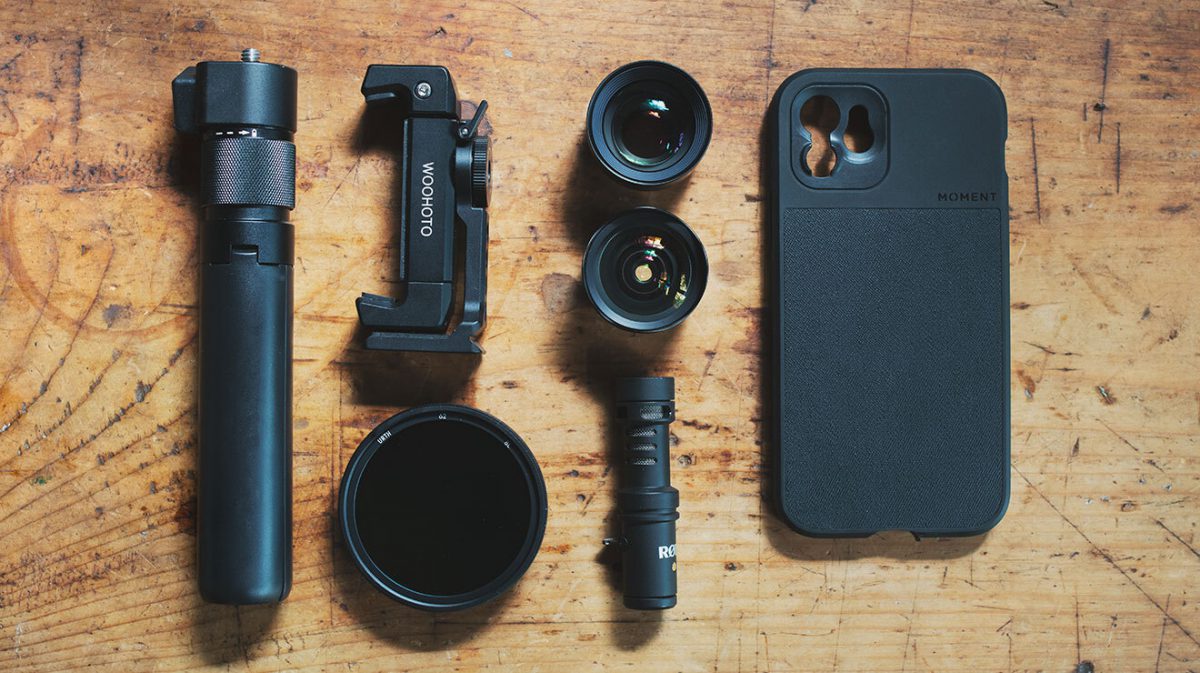It’s no secret that full-fledged DSLRs or camcorders record better video than smartphones. However, it’s important to note that smartphone cameras have come a long way over the years, and might be the exact tool you need in certain situations. In this post, we’ll break down four accessories you can buy to take full advantage of the camera you always have on hand.
Why Use a Smartphone for Video?
There is a well-known saying in the video creation world: the best camera is the one you have on you. At any point in time, usually, that camera is the smartphone you have in your pocket. While most videographers would opt to use a high-quality camera or camcorder, there are a few reasons that a smartphone might lend itself as the better option.
The two main reasons are convenience and cost. In terms of convenience, most people, if not all, already have their smartphones on them 24/7. A smartphone and video accessory kit—an optional but recommended upgrade—will be lighter and easier to transport when doing a video shoot. When it comes to cost, it is essentially free to use your smartphone, since buying professional gear can be quite the investment, especially if you’re just starting out. Using your smartphone is a great way to get your feet wet without investing thousands of dollars at the start of your video journey.
Smartphone Limitations
Using your smartphone as-is will result in good video content. However, with some upgrades, you can turn good video into great video. First, it’s important to understand the limitations associated with working with just a phone. Optics, audio, form factor, and interface are the four categories we’ll cover. In each of these categories, a professional camera will outperform a phone, which is where these upgrades and accessories level the playing field. With a mix of software and phone-specific hardware, you can level up your phone to the best of its ability and improve your overall experience. We’ll outline each of these areas and solutions you can implement below.
1. The Phone Camera Itself
The first limitation to address is the actual camera module on a smartphone. The highest-end smartphones come with one to three different back cameras, all with varying apertures, focal lengths, and sensor sizes. The quality of these cameras tends to vary, not to mention the front-facing cameras which are lower quality than the ones on the back. While these cameras may work for what you’re shooting, you could miss out on the ability to change up lenses, which can help with artistic choices throughout your shoot.
To avoid this problem, many companies over the years have created smartphone-specific lenses you can use with your phone to improve its optics. These are available for purchase in varying focal lengths and styles, which can add a lot of interest to your shots creatively.
Moment Lenses offer some of the best phone lenses on the market today. With options like the Tele 58mm, Wide 16mm, or even the various anamorphic lenses, you’ll be sure to find something that works for your project. They even make mounts for ND filters that are a great option so you don’t have to sacrifice other settings on very bright days.
Be Yourself: The Secret To Loyal Customers

Real estate agents rely on relationships to win new clients. With 30 years of experience, Joe Siciliano shares how to turn outreach into real connection.
2. Improving Recorded Audio
Audio recording is one of the most important aspects of video production, and while phones can certainly get the job done, the audio quality can leave a bit to be desired. Smartphone microphones themselves are fine in certain situations like phone calls and picking up any sounds directly in front of them, but unfortunately, they’re not ideal when you’re trying to isolate specific sounds. The lack of directionality is going to cause your phone to pick up just about every sound in the general area, which is rarely what you want for your video.
An easy solution for this is to pick up an on-camera shotgun mic for your phone. These small but mighty mics make a big difference since they are specifically made to isolate sound from the direction you’re shooting and cancel out other noises. These can range drastically in price, but just about anything will take your mobile filmmaking up a notch.
We recommend Rode’s line of mobile-focused microphones to start. They have various options that plug directly into a headphone jack (if your phone still has one), lightning port for Apple users, or USB-C for Android users. Rode also has mobile lav mic options with multiple inputs if you’re planning on filming a two-person interview or something similar.
3. Creating a Phone Rig
People tend to overlook the size and weight of their filmmaking rig, and since smartphones are small and lightweight, you will likely want more weight and control of your gear to film for a more professional effect. There is a reason you see cages, steady cams, shoulder mounts, and fancy gimbal systems everywhere on professional video shoots. It gives you an immense amount of control you can’t get wielding a camera with your hand. The smaller the phone is, the less control you have, so it will be pretty tough to move with precise control.
Just like with the first two points, there have been huge developments to turn phone counterparts into industry-standard tools. The two options we’d suggest would be a phone cage and accessories or a gimbal.
The SmallRig Video Rig Kit comes with a cage to secure your phone, three handles, and several 3/4ths and cold shoe mounts that you can attach lights, a tripod, or even microphones to. These handles—one on top and two on the sides—will allow you to handle your phone like you would a professional camera for much more stable, intentional shots.
For ultra-smooth shots, you’ll want to use a gimbal. The DJI OM 4 is one of the best ones available at the moment. It uses a 3-axis system to create flawlessly smooth shots without any shaking, and for extra stability, you can attach this system to a tripod.
4. Which App to Use
While the standard smartphone camera app allows you to change exposure and film resolution, there are usually very limited settings. If you’ve ever used a DSLR, mirrorless camera, or camcorder to record video, you’re probably aware of the various settings that are required to get the best footage. Frame rate, focus, exposure, white balance, and color profiles are just a few of the settings you might miss out on if you use the built-in camera app.
That’s where the Filmic Pro app comes in. Their developers realized that all the essential settings are vital for peak performance and created this app that allows you to change those settings directly on your phone. Almost every setting you can think of—from shooting in LOG to checking focus peaking—is available when using the Filmic Pro app.
When combining these four tools, you can take full advantage of the power of your smartphone. Whether you’re just getting into video marketing or a veteran in the field, these options are going to be a valuable addition to your overall video production kit.
Once you’ve created some quality video content with your new smartphone rig, you’ll want to pair it with the proper video marketing tools. Here at SproutVideo, we provide premium video hosting that comes with a whole host of powerful marketing tools to take your video marketing efforts to the next level. Try us free for 30-days to see for yourself.








